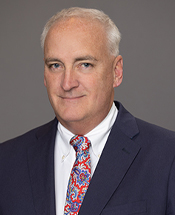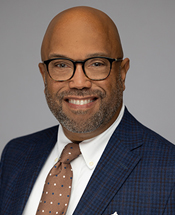As 2024 begins, trends and predictions about the year are helpful tools in looking ahead and planning for a new business landscape. Technology, particularly as it relates to artificial intelligence (AI), will be a big focus in the long term care industry. Also emerging in the industry are advancements and evolutions in architecture, pricing, operations, and staffing as the industry copes with today’s economic conditions and financing.
Medicaid, managed care, reimbursements are also top of mind, however, being that it’s an election year, legislative action is expected to be minimal.
A Promising Year Ahead
 Mark Parkinson, president and CEO of the American Health Care Association (AHCA), delivered a promising forecast for the industry in 2024.
Mark Parkinson, president and CEO of the American Health Care Association (AHCA), delivered a promising forecast for the industry in 2024.
“The sector will hit our pre-pandemic occupancy and then occupancy will keep climbing,” he said. “For the thirteenth year in a row, we will achieve a Medicare increase, and most states will continue to see improvement in Medicaid rates. The sector will have a better year than the politicians. The election will divide the country, except we will all agree on one thing. All of us will be sick of political ads and ready for 2025.”
 LaShuan Bethea, executive director of the National Center for Assisted Living (NCAL), agrees. “I believe 2024 will be an exciting year for assisted living,” she said. “Providers have continued to deliver the high-quality care residents depend on, and that will remain a priority. We’re hopeful that many communities will participate in the Quality Award Program. Rebuilding the workforce and growing the knowledge of and experience with population health management will also provide many opportunities for assisted living in the coming year.”
LaShuan Bethea, executive director of the National Center for Assisted Living (NCAL), agrees. “I believe 2024 will be an exciting year for assisted living,” she said. “Providers have continued to deliver the high-quality care residents depend on, and that will remain a priority. We’re hopeful that many communities will participate in the Quality Award Program. Rebuilding the workforce and growing the knowledge of and experience with population health management will also provide many opportunities for assisted living in the coming year.”

David Gifford, chief medical officer of AHCA/NCAL, said he looks at 2024 optimistically as we continue to see increases in use of long-term care as Baby Boomers begin to reach the age that typically require long term care. “I see continued expansion of managed care and value-based purchasing programs at state and Medicare Advantage plan level,” he said. “The trends with increasing demand for mental health services provides both an opportunity but also a risk if not adequately prepared. Infection control, particularly for respiratory viruses, will remain a national priority.”
Danette Opaczewski, chief operating officer and executive vice president, resident experience at Revel Communities, said that persisting into 2024, inflation poses a multifaceted challenge for the senior housing sector. “On the one hand, senior housing operators are discussing employee wages and how to keep up with the evolving cost of living,” Opaczewski said. “On the other, many seniors are on a fixed income. How will ongoing inflation affect occupancy rates and pricing for the sector? Across the industry, occupancy rates increased in Q3 2023, and they’re projected to reach pre-pandemic levels in 2024.”
Reimbursement and Payment Policies
 Martin Allen, CPA, senior vice president, reimbursement policy, AHCA/NCAL, said he expects 2024 to be a year of innovative partnerships between AHCA/NCAL, state affiliates, providers, and state Medicaid agencies about Medicaid. “As states continue to transition to the patient-driven payment model (PDPM) minimum data set (MDS) or use the optional state assessment (OSA) for Medicaid, we will advocate for the case mix index (CMI) data to be properly used to ensure accurate and sustainable reimbursement,” Allen said. “Our members and affiliates continue to respond to workforce challenges and higher costs, which require our support. We expect these will be opportunities for purposeful collaboration.”
Martin Allen, CPA, senior vice president, reimbursement policy, AHCA/NCAL, said he expects 2024 to be a year of innovative partnerships between AHCA/NCAL, state affiliates, providers, and state Medicaid agencies about Medicaid. “As states continue to transition to the patient-driven payment model (PDPM) minimum data set (MDS) or use the optional state assessment (OSA) for Medicaid, we will advocate for the case mix index (CMI) data to be properly used to ensure accurate and sustainable reimbursement,” Allen said. “Our members and affiliates continue to respond to workforce challenges and higher costs, which require our support. We expect these will be opportunities for purposeful collaboration.”
Allen said on the Medicare fee-for-service (FFS) front, the Centers for Medicare & Medicaid Services (CMS) will continue to look for clean post-pandemic cost and clinical data to build future payment policy. “AHCA is confident that the existing MBI methodology will continue to fairly reimburse the sector’s higher operating costs and the impact of lower census in the next payment rule,” Allen said.
“Managed Medicare and Medicaid are here to stay, but AHCA will continue to advocate for policies which support beneficiaries and adhere to underlying FFS regulations,” said Allen. “We must continue to oppose onerous authorization policies and denial practices, which limit patient access and cause financial harm. In addition, we expect and support continued growth and focus on provider-led population health management initiatives.”
Legislation and Regulatory Actions
 Legislatively speaking, Clif Porter, senior vice president of government relations, AHCA/NCAL, said that given this is a presidential election year with an incumbent president, history implies that major, controversial legislative activities will not occur because the administration is focused on re-election.
Legislatively speaking, Clif Porter, senior vice president of government relations, AHCA/NCAL, said that given this is a presidential election year with an incumbent president, history implies that major, controversial legislative activities will not occur because the administration is focused on re-election.
“This phenomenon applies to Congress as well,” Porter said. “However, the most consequential issue (staffing mandate) we have faced in recent years is likely going to be finalized in 2024. It is imperative that we do everything possible to shape the outcome of this rule in a way that is implementable for our members,” said Porter. He said AHCA/NCAL will also be focused on workforce enhancements and policies that help us increase the supply of caregivers.
“Our CNA Lockout and Temporary Nursing Assistant legislation is a top priority as these efforts actually help our operators control their own destiny,” Porter said. “There will continue to be scrutiny regarding ownership transparency in both the skilled nursing and assisted living space. I wouldn’t be surprised if we see intensified hearing activity on a variety of issues. I am confident that we will be able to impact the outcome of the staffing mandate.”
 Holly Harmon, senior vice president of quality, regulatory, and clinical services, AHCA/NCAL, said she is expecting many proposed rules in 2024, including one on health care system resiliency and modernization that is anticipated to include emergency preparedness for Medicare- and Medicaid-participating providers and suppliers.
Holly Harmon, senior vice president of quality, regulatory, and clinical services, AHCA/NCAL, said she is expecting many proposed rules in 2024, including one on health care system resiliency and modernization that is anticipated to include emergency preparedness for Medicare- and Medicaid-participating providers and suppliers.
“CMS is looking for ways to improve efficiencies of the survey process for nursing homes, including survey testing in early 2024,” Harmon said. “This could help to reduce unnecessary administrative and workforce demands for both state survey agencies and nursing homes, which is important to address the chronic survey backlogs across the nation.”
She said nursing homes and assisted living communities will continue to identify and strengthen ways for providing the highest quality care possible to the residents they serve. The AHCA/NCAL National Quality Award Program will continue to grow as a proven path to promote improved and sustained performance in long term care settings.
Increasing Innovation and Technology
Sara Wilson, CEO, Home Assist Health, said the year will again be filled with rapid demand and increasing complexities. “Competition will intensify, leading to higher levels of innovation, including the use of artificial intelligence,” Wilson said. “New AI tools will provide a significant impact on both dementia and Alzheimer’s patients.”
These tools include helping medical providers better and more quickly assess patients, as well as in-the-moment strategies to help caregivers defuse situations. “It will help to assist someone with dementia in keeping a daily routine for personal care needs such as eating, bathing, etc. These solutions will provide the needed support to families in an oftentimes overwhelming situation,” said Wilson.
Mark Ustin, partner, Farrell Fritz, P.C., said health care policy will continue to work to catch up to technology as the rise of artificial intelligence offers policy challenges. “Anytime a machine ‘thinks’ for itself in the health care space, that will raise concerns about data privacy and security,” Ustin said. “For example, what exactly is that machine doing with your data? Or regarding patient autonomy and consent—to what extent can patients interact with that AI and be sure they are getting the answers they need?”
Ustin continued, “When it comes to scope of practice and responsibility, what decisions are being made by AI rather than licensed professionals, and who is responsible when those decisions are wrong? On the other hand, AI creates unprecedented opportunities in precision medicine and may even help to span the disparity gap by providing new avenues of access to health care services for populations who do not have such access now. But that only works if those populations have access to those AI options.”
Steve Jorgenson, president and CEO of Solterra Companies, said he’s investing in technology. “A comprehensive suite of eHR tools solves the important challenges assisted living communities face using fast and secure technology,” Jorgenson said. “The goal is to automate our processes, from admissions to discharge, with real-time information. Onboarding a new resident and managing their ongoing care using technology gives us a clearer snapshot of a resident’s health status and allows caregivers to be more efficient.”
Jorgenson said, “Technology enables us to gather current data and track changes that are needed in the continuum of care. This data allows for easier conversations with family when a resident needs more care. There is real data there to back up a resident’s care plan.”
Opaczewski said technology can also assist communities in augmenting security measures when prioritizing the safety of their communities. “New technologies can provide improved communication tools for visitors, facial recognition features, and enhanced tracking mechanisms that can proactively protect residents, team members, and communities in real-time,” she said.
Improved Workforce Management
Todd Walrath, CEO of ShiftMed, said 2024 will bring greater emphasis on optimizing staffing processes and workforce management, reflecting a strategic move towards greater efficiency and precision in the delivery of health care services.
“By adopting new workforce models and using data-driven insights, health care organizations can predict staffing needs more effectively and allocate resources based on this,” Walrath said.
“This shift highlights a dedication to improving patient care through precise and responsive practices, transforming how health care facilities handle staffing intricacies by ensuring a more agile and responsive workforce.”
Jorgenson said, operationally, the main focus for the new year is staffing. “Solterra has retention under control now coming out of COVID-19, and we’re running under 30 percent attrition for hourly positions,” he said. “We're very focused on growing our employees and promoting from within. That helps tremendously with retention. We give employees the ability to grow in their careers. Investing in someone to get their administrative license, and training employees the right way is key.”
Jorgenson said staffing strategy contributes to another 2024 goal, stabilizing expenses. “In assisted living, we rely on caregivers, and having those team members on our payroll versus using an outside agency and contract labor is so much healthier for our bottom line,” he said.
“Contract workers are more expensive for the operator, and we have luckily seen a positive trajectory for internal hiring and retention.”
Architecture and Design Evolve
Architecture trends for 2024 will appeal to residents, their families, and staff members. David Banta, senior design leader and partner, BKV Group, said to help address staff shortages and turnover, he’s upgrading staff lounges, bringing them out of basements, and giving them more than a counter and microwave.
“We’ve added some sleep modules that help the overnight shift workers get some rest if possible,” Banta said. “We include more natural light and have direct access to outdoor spaces such as small patios where they can ‘get away’ for a bit, congregate, and relax.”
Banta is also ridding his designs of long corridors. “This helps reduce the walks residents have to take to get to places like the dining rooms and other amenity spaces,” he said. “It also shortens the distance for staff to walk to care for multiple patients. No longer are there large, centralized caring stations. We’ve added a few ‘touchdown’ points in the hallways where staff can go to take notes or update resident information on a computer. Usually, a small nook with a counter or piece of furniture so it is not obtrusive.”
Banta also is adding maneuverability near the residents’ bedrooms and bathrooms. “It’s worth the extra cost that comes with more square footage in rooms because it gives staff more room to lift or relocate residents while reducing staff injuries, thus workers’ compensation claims,” he said. “It also gives family members more space as they are involved in a lot of the cases with the care of their loved ones.”
Addressing Behavioral and Mental Health Needs
Ustin said this year is likely to see a continuation of many of the trends in health care from 2023. “Probably the most significant will, paradoxically, be a continued focus on things outside of, but nonetheless important to, health care,” he said.
This year will bring an ever-increasing focus on behavioral health care. “Mental health issues have been front-and-center in the immediate aftermath of COVID-19, and while the fallout seems not to be as bad as we feared, the more we learn about mental health, the more we realize the profound connection it has to physical health,” Ustin said.
“Substance use disorders continue to be a concern—in fact, probably the primary health care concern now that COVID-19 is waning. Providers of all kinds, and particularly long-term and senior care providers, will be called upon to provide new options in both these spaces,” said Ustin.
Demand for Personalized Care
According to Ustin, aging baby boomers are continuing to demand options that look very different from the institutional services offered to their parent’s generation.
Ustin continued, “Providers of all types will continue to consider and implement new options for specialty care, including new options for women’s health, LGBTQ+, and disability services. This will be true in the long-term care space as much as anywhere. There should be a continuing focus on making sure that all populations share access to all the new developments in health care—including developments in health-related social needs, lifestyle medicine, behavioral health care, precision medicine, and AI, among others. This means that these changes cannot just occur in the self-pay or commercial markets—Medicare and Medicaid need to be a part of that change.”
Opaczewski said personalized resident experiences will be a continued focus in 2024. “Amidst the dynamic landscape of senior living, a one-size-fits-all approach no longer suffices, and providers must offer customizable services and amenities that cater to a wide range of preferences,” she said.
Paul Bergeron is a freelance writer based in Herndon, VA.